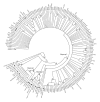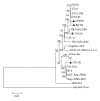Genetic diversity analysis of genotype 2 porcine reproductive and respiratory syndrome viruses emerging in recent years in China
- PMID: 24719885
- PMCID: PMC3955690
- DOI: 10.1155/2014/748068
Genetic diversity analysis of genotype 2 porcine reproductive and respiratory syndrome viruses emerging in recent years in China
Abstract
Porcine reproductive and respiratory syndrome virus (PRRSV) is characterized by its extensive genetic diversity. Here we analyzed 101 sequences of NSP2 hypervariable region, 123 ORF3 sequences, and 118 ORF5 sequences from 128 PRRSV-positive clinical samples collected in different areas of China during 2008-early 2012. The results indicated that the amino acid identities of the three genes among these sequences were 87.6%-100%, 92.5%-100%, and 77%-100%, respectively. Meanwhile, 4 novel patterns of deletion and insertion in NSP2 region or GP5 were first found. The phylogenetic analysis on these 3 genes revealed that the Chinese PRRSV strains could be divided into three subgroups; majority of genes analyzed here were clustered in subgroup 3 with multiple branches; the strains with 30-aa deletion in NSP2-coding region were still the dominant virus in the field. Further phylogenetic analysis on four obtained complete genomic sequences showed that they were clustered into different branches with the Chinese corresponding representative strains. Our analyses suggest that the genetic diversity of genotype 2 PRRSV in the field displays a tendency of increasing in recent years in China, and the 30-aa deletion in NSP2-coding region should be no longer defined as the molecular marker of the Chinese HP-PRRSV.
Figures






Similar articles
-
Genetic analysis of porcine productive and respiratory syndrome virus between 2013 and 2014 in Southern parts of China: identification of several novel strains with amino acid deletions or insertions in nsp2.BMC Vet Res. 2019 May 24;15(1):171. doi: 10.1186/s12917-019-1906-9. BMC Vet Res. 2019. PMID: 31126340 Free PMC article.
-
Diversity of porcine reproductive and respiratory syndrome virus in Shandong, China.Acta Virol. 2021;65(3):303-306. doi: 10.4149/av_2021_305. Acta Virol. 2021. PMID: 34565158
-
Genetic characterization of 11 porcine reproductive and respiratory syndrome virus isolates in South China from 2014 to 2015.Virol J. 2017 Jul 24;14(1):139. doi: 10.1186/s12985-017-0807-4. Virol J. 2017. PMID: 28738888 Free PMC article.
-
Molecular characterization and recombination analysis of porcine reproductive and respiratory syndrome virus emerged in southwestern China during 2012-2016.Virus Genes. 2018 Feb;54(1):98-110. doi: 10.1007/s11262-017-1519-y. Epub 2017 Nov 14. Virus Genes. 2018. PMID: 29138994
-
Recent Progress in Studies of Porcine Reproductive and Respiratory Syndrome Virus 1 in China.Viruses. 2023 Jul 10;15(7):1528. doi: 10.3390/v15071528. Viruses. 2023. PMID: 37515213 Free PMC article. Review.
Cited by
-
Genetic Characteristics of Three Single-Farm-Isolated Porcine Reproductive and Respiratory Syndrome Viruses with Novel Recombination among NADC30-Like, JXA1-Like, and QYYZ-Like Strains.Transbound Emerg Dis. 2023 Jul 22;2023:8871321. doi: 10.1155/2023/8871321. eCollection 2023. Transbound Emerg Dis. 2023. PMID: 40303660 Free PMC article.
-
Epidemiology and genetic characterization of porcine reproductive and respiratory syndrome virus in Fujian Province, China, from 2023 to 2024.Front Vet Sci. 2025 Jul 2;12:1634353. doi: 10.3389/fvets.2025.1634353. eCollection 2025. Front Vet Sci. 2025. PMID: 40671826 Free PMC article.
-
The Non-structural Protein 5 and Matrix Protein Are Antigenic Targets of T Cell Immunity to Genotype 1 Porcine Reproductive and Respiratory Syndrome Viruses.Front Immunol. 2016 Feb 16;7:40. doi: 10.3389/fimmu.2016.00040. eCollection 2016. Front Immunol. 2016. PMID: 26909080 Free PMC article.
-
Genetic variation and recombination analysis of the GP5 gene of the porcine reproductive and respiratory syndrome virus in Thailand.Front Vet Sci. 2024 Aug 8;11:1444040. doi: 10.3389/fvets.2024.1444040. eCollection 2024. Front Vet Sci. 2024. PMID: 39176398 Free PMC article.
-
Genetic Characterization and Pathogenicity of a Novel Recombined Porcine Reproductive and Respiratory Syndrome Virus 2 among Nadc30-Like, Jxa1-Like, and Mlv-Like Strains.Viruses. 2018 Oct 9;10(10):551. doi: 10.3390/v10100551. Viruses. 2018. PMID: 30304818 Free PMC article.
References
-
- Wensvoort G, de Kluyver EP, Pol JMA, et al. Lelystad virus, the cause of porcine epidemic abortion and respiratory syndrome: a review of mystery swine disease research at Lelystad. Veterinary Microbiology. 1992;33(1–4):185–193. - PubMed
-
- Garner MG, Whan IF, Gard GP, Phillips D. The expected economic impact of selected exotic diseases on the pig industry of Australia. OIE Revue Scientifique et Technique. 2001;20(3):671–685. - PubMed
-
- Neumann EJ, Kliebenstein JB, Johnson CD, et al. Assessment of the economic impact of porcine reproductive and respiratory syndrome on swine production in the United States. Journal of the American Veterinary Medical Association. 2005;227(3):385–392. - PubMed
-
- Pejsak Z, Markowska-Daniel I. Losses due to porcine reproductive and respiratory syndrome in a large swine farm. Comparative Immunology, Microbiology and Infectious Diseases. 1997;20(4):345–352. - PubMed
Publication types
MeSH terms
LinkOut - more resources
Full Text Sources
Other Literature Sources
Research Materials
Miscellaneous

